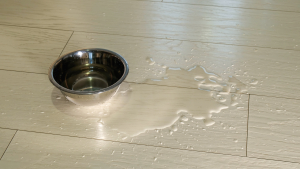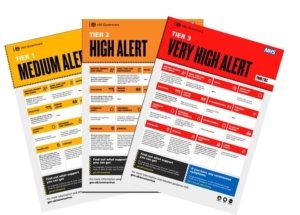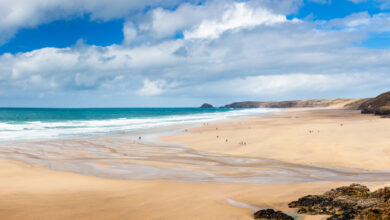How to manage floor contamination to prevent slips

Last Updated on October 6, 2025 by admin
Did you know, the amount of contamination needed to make a smooth floor slippery is very small. A slightly damp or sticky floor is just as slippery as one with a deep spill of water – the obvious spill will just be easier to spot.
When we talk about contamination, we refer to anything on a floor surface that can make it slippery and therefore hazardous. This can include:
· Water or detergent
· Dust, mud and other dry contaminants
· Oil and grease
By controlling contamination, it is possible to reduce the risk of slips and falls on smooth, shiny floors, often found in holiday lets (kitchens, bathrooms, hallways). Preventing Slips: Flooring
Cleaning methods for greasy floors
Learning how to control contamination that causes slips is vital. As a holiday let owner or landlord, making sure smooth, shiny floors stay clean and dry can help you create a safe, welcoming environment.
Call: 01237 429 444
Request a Quote: boshers.co.uk/get-your-quote/
Walk-in contamination
Control walk-in contamination at the entrance to your building(s), particularly when adverse weather conditions are on the horizon! Good entrance design should include adequate matting and a well-designed canopy or porch. Good drainage outside an entrance can reduce the volume of water and mud that can be walked-in, but it must be properly maintained.
Entrance matting of a suitable size and material needs to be kept clean on a regular basis. Use absorbent fabric mats designed to remove water from shoes, rather than rubber or metal ‘scraper’ mats to remove dirt. Several meters of matting may be necessary to fully dry your guests’ footwear. To get an idea of how effective your current entrances are, look at them on rainy days and see if wet footprints can still be seen beyond your current matting.
Best practice for spill cleanup
Adopting a spill response procedure, should a contaminant spill onto your floors, should be an important part of your risk management and Health and Safety procedures.
Follow good cleaning practices to make sure flooring remains dry when it is cleaned. The floor should also be free from any contamination from detergents, waxes or other treatments used.
Check regularly for contamination so that spills can be identified and removed in a timely manner, especially in high-risk areas such as food preparation areas or when the weather is bad. More frequent checks may be needed where there is high footfall. If events (such as fetes and open days) are planned that have the potential to introduce additional sources of contamination, you will need to make sure all spill clean-ups are dealt with quickly.
Dry-mopping and squeegee use
Dry-mopping removes dust, dirt, and debris without water, preventing streaks and protecting surfaces, and it is ideal for the daily maintenance of hard floors. Squeegee use ensures effective water removal after wet cleaning, leaving floors dry, safe, and streak-free. Together, they maintain cleanliness, reduce slip risks, and prolong flooring lifespan.

Implementing appropriate procedures
Implement appropriate procedures to clean up unexpected spills. Most wet spills can be dried up without the need for wet mopping, which will only increase the area of wet flooring. Greasy spills, such as food, will need to be cleaned using a detergent solution. Preventing Slips: Cleaning
Mitigating the risk of spills
Reduce the risk of spills, for example by supplying lids on drinks cups, providing trays in eating areas, or adding drip trays to trolleys. Most wet spills can be dried up without the need for wet mopping, which will only increase the area of wet flooring. Greasy spills, such as food, will need to be cleaned using a detergent solution.
Choosing detergents for oily floors
When you’re navigating your way through a wide range of cleaning products to choose from, prioritise products with strong degreasing properties. Citrus-based or solvent cleaners can also help cut through grease while leaving a fresh scent. Bear in mind, however, to always consider the type of floors you have in your property. Delicate and sensitive surfaces like stone or sealed wood, often found in older and listed homes, may require a gentler, pH-neutral detergent to prevent damage. Make sure you dilute the product to the manufacturer’s specifications and remember to rinse, and if necessary, repeat.
Barriers and signs when cleaning
Knowing when to use barriers and remove signs after floors dry is an essential part of Health and Safety, and hosting paying and non-paying guests. Barriers should be used during floor cleaning to keep people away from wet or oily surfaces, reducing slip and fall risks. They need to be placed in busy areas, entrances, and corridors where foot traffic is high.
Clear warning signs must remain in place until the floor is completely dry. Once the surface is safe, promptly remove the barriers and signs to avoid confusion and maintain a hazard-free environment.
Providing employee training
Provide training and information for staff outlining the importance of good housekeeping standards. Your employees need to know the correct safety procedures to follow and best practice with regards to cleaning and maintenance.
If you would like a quote for your Holiday Let Insurance, don’t hesitate to get in touch. To discuss Home Insurance for your holiday home, cottage complex or second home, contact us today.
Call: 01237 429 444
Request a Quote: boshers.co.uk/get-your-quote/
This guidance is provided for information purposes and is general and educational in nature and does not constitute legal advice. You are free to choose whether or not to use it and it should not be considered a substitute for seeking professional help in specific circumstances.




